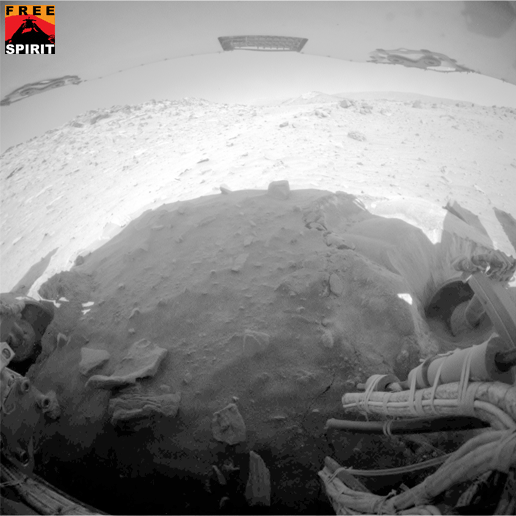Stuck Rover on Mars Can Still Do Science

NASA'sbeleaguered Mars rover Spirit may no longer be much of a rover, but it's notthe end of the road for her yet. The semi-stuck robot still has plenty ofscience left to do on the red planet, mission scientists say.
"There?sactually a whole class of scientific objectives that you can only address froma vehicle that doesn?t move. So far we've pretty much tended to ignorethose," said rover mission principal investigator Steven Squyres ofCornell University in Ithaca, New York.
Squyres andother mission mangers announcedlast week that they were halting the effort to free Spiritfrom the sand trap it has been stuck in since May and shifting efforts topreparing the rover for the upcoming Martian winter.
The rover'shandlers will try over the next week to position the rover to maximize theamount of solar radiation it receives to give it the best chance of making itthrough the winter.
"Energyis getting so low that we think we only have, you know, at maximum anotherhalf-dozen drives to be able to do that before we have to hunker down and getthrough the winter campaign," said science team member Ray Arvidson of theWashington University in St. Louis.
That wintercampaign won't see the rover doing much: "In the dead of winter, it cantry to survive, that's about it," Arvidson told SPACE.com.
Wintercampaign
Get the Space.com Newsletter
Breaking space news, the latest updates on rocket launches, skywatching events and more!
From nowuntil the Martian winter solstice in May, the vehicle will wake up during theday and if it thinks it has enough energy, it will wait for a signal fromEarth. If it has a bit more energy, it will take some atmospheric measurementsand do some radio science.
Spirit isequipped with an X-band transmitter and receiver on its high-gain antenna thatcan find the Deep Space Network and establish communication over about 20 to 30minutes. Doppler tracking of the rover's signal can "very, very accuratelylocate the rover." Those measurements added up over six months could beused to locate the precession, or wobble, of Mars' spin axis.
Smallvariations in the precession can in part be driven by the properties of a planet'score, such how big it is or whether it is liquid or solid.
"Sothis could provide major new information about the interior," Arvidsonsaid.
A roverwouldn't be able to do this kind of science because it would constantly changeposition, so a stationary target is needed, Squyres noted. Spirit's predicamentprovides the perfect opportunity to do this kind of science, Arvidson said.
Spirit willalso operate a weather station while it's stuck in place.
The rover and itstwin Opportunity have been exploring different parts of Mars since January 2004and far outlasted their initial 90-day missions. Both rovers are now in their seventh year of Mars exploration.
YearEight?
If Spiritmakes it through the winter, the next objective will be to see if it can findany more of the intriguinglayered soil it inadvertently found when it got stuck.
Over thepast few months, scientists have had ample time to investigate the unusualfeature that Spirit was mired in and it has turned out to be one of the mostgeologically interesting places the rover has visited in its six years on thered planet.
Thecompounds that Spirit has found in these layered soils indicates that the siteperiodically becomes slightly wet, with some chemicals dissolving into thewater and others being corroded by it. Arvidson says this is likely the resultof snow packs being periodically deposited on the site when Mars is at a higherdegree of tilt with respect to the sun.
Whatscientists want to know now is whether or not this spot is unique, or whetherthis layering is a more widespread feature.
If the teamcan pop Spirit out of its current spot (and it has moved backward by about 20centimeters over the last week, Arvidson noted), it might be able to drive tothe center of the crater it has been stuck in, or features a few meters to thenorth or south of the crater.
Morelong-range driving is out of the question, because even if it is freed, Spiritwill still only be a 4-wheel-drive vehicle ? good if you're climbing mountainson Earth, but not if you're a Mars rover. The rover has six wheels, like itsrobotic twin Opportunity, but two of its wheels are broken.
"Withfour-wheel drive in this pretty dicey area, we're not going to go veryfar," Arvidson said.
Arvidsonalready has a few sites in mind to check out once spring rolls around.
With thebackwards motions done over the past week, "we already have newly exposedsoils," Arvidson said. So even though Spirit will rove no more,"there's still a lot to do," he added.
How muchSpirit will be able to do in this new phase of the rovermission isn't known; even mission managers don't know how long the hobbledrobot will last.
"Arewe going to have an eighth year?" Arvidson asked.
- Video - Spirit: The Little Mars Rover That Could
- Trapped Mars Rover Turning New Corner, Scientists Say
- NASA's 10 Greatest Science Missions
Join our Space Forums to keep talking space on the latest missions, night sky and more! And if you have a news tip, correction or comment, let us know at: community@space.com.

Andrea Thompson is an associate editor at Scientific American, where she covers sustainability, energy and the environment. Prior to that, she was a senior writer covering climate science at Climate Central and a reporter and editor at Live Science, where she primarily covered Earth science and the environment. She holds a graduate degree in science health and environmental reporting from New York University, as well as a bachelor of science and and masters of science in atmospheric chemistry from the Georgia Institute of Technology.









